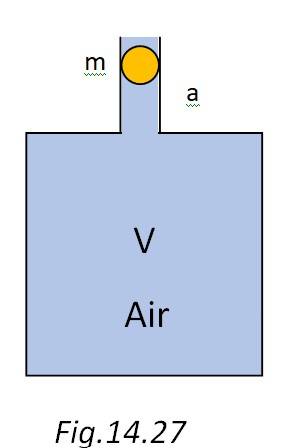Oscillations
Get insights from 99 questions on Oscillations, answered by students, alumni, and experts. You may also ask and answer any question you like about Oscillations
Follow Ask QuestionQuestions
Discussions
Active Users
Followers
New answer posted
5 months agoContributor-Level 10
This is a long answer type question as classified in NCERT Exemplar
Let the log be passed and the vertical displacement at the vertical displacement at the equilibrium position
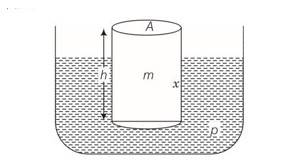
So mg= buoyant forces =
When it is displaced by further displacement x, the buoyant force is A (xo+x)
Net restoring force = buoyant forces -weight
=A (xo+x) -mg
=A
As displacement x is downward and restoring force is upward
Frestoring =-A =-kx
So motion is SHM
Acceleration a=Frestoring/m=-kx/m
a=-w2x
w2=k/m
w=
T= 2
New answer posted
5 months agoContributor-Level 10
This is a long answer type question as classified in NCERT Exemplar
(a) When the support of the hand is removed the body oscillates about mean position
Suppose x is the maximum extension in the spring when it reaches the lowest point in oscillation.
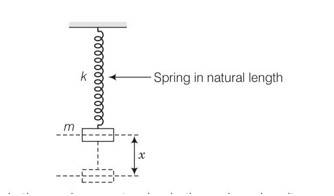
Loss in PE of the block=mgx
Gain in elastic potential energy =1/2 kx2
By energy conservation we cam say that
Mgx=1/2kx2
Or x= 2mg/k
Now the mean position of oscillation will be when the block is balanced by spring
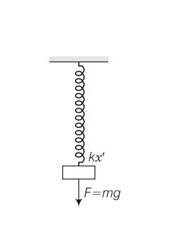
If x' is the extension in that case
F= kx'
F=mg
Mg=kx'
X'=mg/k
By dividing x by x'
x/x'=
so x=2x'
x'=4/2 =2cm
but the displacement of mass from the mean position when spring attains its natural l
New answer posted
5 months agoContributor-Level 10
This is a long answer type question as classified in NCERT Exemplar
(a) The weight of the body changes during oscillations.
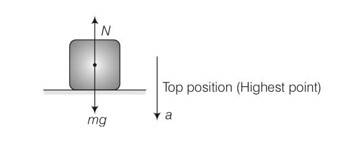
(b) Considering the situations in two extreme positions
we can say mg-N= ma
so at the highest point the platform is accelerating downward.
N=mg-ma
a=w2A
N=mg-mw2A
A= amplitude of motion m=50kg v=2m/s
w=2
A= 5cm = 5
N= 50
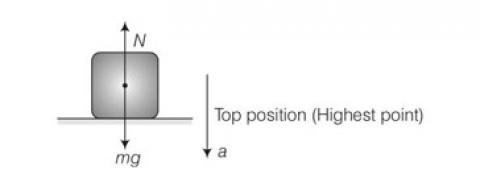
When it is accelerating towards mean position that is vertically upwards
N-mg=ma=Mw2A
N=mg+mw2A
N=m (g+w2A)
N= 50 [9.8+ ]
N= 884N
Machine reads the normal reaction
Maximum weight =884N
Minimum weight=95.5N
New answer posted
7 months agoContributor-Level 10
The displacement equation for an oscillating mass is given by : x = Acos ( , where
A = the amplitude
x = the displacement
Velocity, V = = -A t +
At t = 0, x = , = ….(i)
And = = A …….(ii)
Squaring and adding, we get
, A =
New answer posted
7 months agoContributor-Level 10
Amplitude = 5 cm = 0.05 m
Time period, T = 0.2 s
(a) For displacement x = 5 cm = 0.05m
Acceleration is given by a = = = = 5 m/s
Velocity is given by V = = = 0
(b) For displacement x = 3 cm = 0.03m
Acceleration is given by a = = = = 3 m/s
Velocity is given by V = = = 0.4
(c) For displacement x = 0 cm = 0 m
Acceleration is given by a = = = = m/s
Velocity is given by V = = = 0.5
New answer posted
7 months agoContributor-Level 10
Mass of the circular disc, m = 10 kg
Radius of the disc, r = 15 cm = 0.15 m
The torsional oscillation of the disc have a time period, T = 1.5 s
The moment of inertia of the disc I = m = = 0.1125
Time period, T = 2 ,
Torsional spring constant, = 1.974 Nm/rad
New answer posted
7 months agoContributor-Level 10
The equation of displacement of a particle executing SHM at an instant t is given bas:
x = Asin , where A = Amplitude of oscillation and = angular frequency =
The velocity of the particle, v = = A
The kinetic energy of the particle = M = M = M
The potential energy of the particle = k = k
For time period T, the average kinetic energy over a single cycle is given as :
= =
= = = = …….(i)
Average potential energy
New answer posted
7 months agoContributor-Level 10
Mass of the automobile, m = 3000 kg
Displacement of the suspension system, x = 15 cm = 0.15 m
There are 4 springs in parallel to the support of the mass of the automobile.
(a) The equation for restoring force for the system, F = -4kx = mg, where k is the spring constant of the suspension system
Time period, T = 2 and
k = = N/m
(b) Each wheel supports a mass, M = 3000/4 = 750 kg
For damping factor b, the equation for displacement is written as
x =
The amplitude of oscillation decrease by 50%. Therefore x = =
=
b =
T = 2 = 2 = 0.7773 s
b =
New answer posted
7 months agoContributor-Level 10
Volume of the air chamber = V
Area of cross-section of the neck = a
Mass of the ball = m
The pressure inside the chamber is equal to atmospheric pressure.
Let the ball be depressed by x units. As a result of depression, there would be decrease in volume and an increase of pressure inside the cylinder.
Decrease in the volume, = ax
Volumetric strain = =
Bulk modulus of air, B = = : here stress is the increase in pressure. The negative sign indicates that pressure increases with a decrease in volume.
So p =
The restoring force acting on the ball, F = p = …. (i)
In SHM,
New answer posted
7 months agoContributor-Level 10
Area of cross section of the U tube = A
Density of the mercury column =
Acceleration due to gravity = g
Restoring force, F = Weight of the mercury column of a certain height = - (Volume
F = -(A = -2A = -k
Where, 2h is the height of the mercury columns in two arms
The constant k is given by k = = 2A
Time period, T = 2 = 2 , where m is the mass of the mercury column
Let l be the length of the total mercury in the U tube
Mass of the mercury, m = Volume of the mercury density of mercury = Al
Hence T = 2 = 2
Taking an Exam? Selecting a College?
Get authentic answers from experts, students and alumni that you won't find anywhere else
Sign Up on ShikshaOn Shiksha, get access to
- 66k Colleges
- 1.2k Exams
- 680k Reviews
- 1800k Answers

